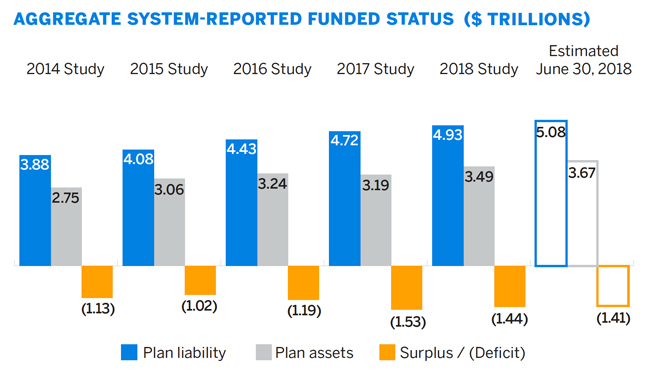Introduction
The Milliman Public Pension Funding Study annually explores the funded status of the 100 largest U.S. public pension plans. We report the plan sponsor’s own assessment of how well funded a plan is. We also recalibrate the liability for each plan based on our independent assessment of the expected real return on each plan’s investments.
Beginning with our 2016 study, we have utilized the Total Pension Liability figures that are used for financial reporting under the accounting standards that apply to governmental entities, Governmental Accounting Standards Board (GASB) 67/68. GASB 67/68 reporting requirements mandate use of a uniform and consistent liability measurement, so there is more comparability across plans than is the case with the liability figures that the plans use to determine contribution amounts (see the sidebar “Financial Reporting vs. Funding”). GASB 67/68 also requires disclosure of metrics that enable us to project the Total Pension Liability forward beyond the plan sponsor’s fiscal year-end. This allows us to estimate how a plan’s assets and liabilities, i.e., the plan’s funded status, will respond to changing market conditions.
This 2018 report is based on information that was reported by the plan sponsors at their most recent fiscal year-ends—June 30, 2017, is the measurement date for most of the plans in our 2018 study. At that time, plan assets were riding the wave of strong equity returns in the first half of 2017. Total plan assets as of the last fiscal year-ends grew to $3.49 trillion, up from $3.19 trillion as of the prior fiscal year-ends (generally June 30, 2016). Market performance since the last fiscal year-ends has been a mixed bag, with strong performance in the latter half of 2017, relatively flat performance in the first half of 2018, and considerable volatility toward the end of 2018. We estimate that aggregate plan assets rose to $3.67 trillion as of June 30, 2018. We estimate that the plans experienced a median annualized return on assets of 8.29% in the period between their fiscal year-ends and June 30, 2018.
Highlights
- As of June 30, 2018, the aggregate funded ratio is estimated to be 72.1%, with plan assets earning slightly more than anticipated by the plans’ interest rate assumptions
- Nearly one-half of the plans reduced the interest rate assumptions they use for determining contribution amounts
- Adoption of more conservative assumptions added $73 billion to reported liabilities; plan changes shaved off $14 billion
Aggregate system-reported funded status ($ trillions)\

Note: The plan liability amounts from the 2014 and 2015 studies are the accrued liability used for funding purposes; the 2016 through 2018 studies report the GASB 67/68 Total Pension Liability.
The aggregate Total Pension Liability reported at the last fiscal year-ends was $4.93 trillion, growing from $4.72 trillion as of the prior fiscal year-ends. We estimate that the Total Pension Liability has since passed the $5 trillion mark as of June 30, 2018. The aggregate system-reported underfunding as of the last fiscal yearends stood at $1.44 trillion, and we estimate that the underfunding has narrowed just slightly to $1.41 trillion as of June 30, 2018. To the extent that systems lowered their interest rate assumptions after the fiscal year-ends reflected in this report, our estimated figures as of June 30, 2018, likely understate the aggregate liability and the aggregate underfunding.
Study technical appendix
Methodology
This study is based on the most recently available Comprehensive Annual Financial Reports for the 100 largest public pension systems, which reflect measurement dates ranging from June 30, 2015, to December 31, 2017; 91 are from June 30, 2017, or later. For the purposes of this study, the reported asset allocation of each of the plans has been analyzed to determine an independent measure of the expected long-term median real rate of return on plan assets. The sponsor-reported Total Pension Liability for each plan has then been recalibrated to reflect this independently determined investment return assumption. This study therefore adjusts for differences between each plan’s reported discount rate and an independently calibrated current market assessment of the expected real return based on actual asset allocations. This study is not intended to price the plans’ liabilities for purposes of determining contribution amounts or near-term plan settlement purposes nor to analyze the funding of individual plans.
Public pension mortality
The Society of Actuaries (SOA) periodically publishes mortality tables for use in valuing pension liabilities. In August 2018, the SOA issued an exposure draft of mortality tables that are based on experience exclusively from public pension plans. We expect that public plans and their actuaries are reviewing these tables and evaluating whether to eventually adopt these tables.
To the extent that use of a new mortality table projects longer life spans, accrued liabilities will increase and funded ratios will decrease.